Blandford, Dorset
Up to 1834
Blandford Forum had a "House of Industry" at the end of East Street dating back to at least 1761. A parliamentary report of 1777 recorded parish workhouses in operation in Blandford Forum for up to 50 inmates, and at Tarrant Gunvil for up to five.
Eden, in his 1797 survey of the poor in England, provides a picture of Blandford's workhouse:
After 1834
Blandford Poor Law Union was formed on 5th December 1835. Its operation was overseen by an elected Board of Guardians, 35 in number, representing its 33 constituent parishes as listed below (figures in brackets indicate numbers of Guardians if more than one):
County of Dorset:
Almer, Anderson, Blandford Forum (3), Blandford St Mary, Bryanston, Charlton Marshall, Durweston, Hilton, Iwerne Courtnay alias Shroton, Langton Long Blandford, Milbourne St Andrew, Milbourne Styleham, Milton Abbas, Pimperne, Spettisbury, Steepleton Preston, Tarrant Crawford, Tarrant Gunville, Tarrant Hinton, Tarrant Keynston, Tarrant Launceston, Tarrant Monkton, Tarrant Rawston, Tarrant Rushton, Turnworth, Winterborne Clenston, Winterborne Houghton, Winterborne Kingston, Winterborne Stickland, Winterborne Tomson, Winterborne Whitchurch, Winterborne Zelston.
Later Addition: Chettle (from 1894), Farnham (from 1894).
The population falling within the union at the 1831 census had been 13,056 with parishes ranging from Steepleton Preston (population 36) to Blandford Forum itself (3,109). The average annual poor-rate expenditure for the period 1833-5 had been £8,387 or 12s.10d. per head of the population.
The new Blandford union took over the old parish workhouse and enlarged it to accommodate 250 inmates.
In October 1836, the Clerk was ordered to "write to the Guardians of Wimborne Union and request the Guardians to forward one of their mortars used for pounding bones for the inspection of the Board."
The following month, the Master and Matron complained that there were insufficient able-bodied women in the workhouse to perform the household work. The Relieving Officers of the various parishes were ordered to "look over their Out-Relief lists" with a view to sending more able-bodied women into the workhouse.
A new union workhouse was erected in 1856-7 on a site to the west of the Salisbury Road in Blandford. The old building was then sold off for £1,200. The new workhouse, designed by Christopher C Creeke, comprised an entrance block, a T-shaped main block, and some small ancillary buildings. The site location and layout are shown on the 1929 map below, by which time the workhouse was officially known as Blandford Poor Law Institution.
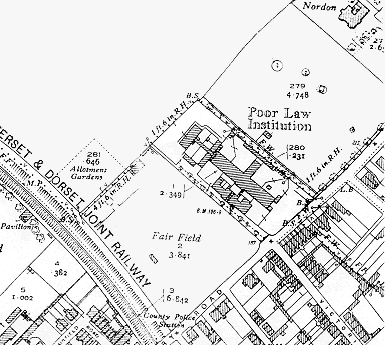
Blandford site map, 1929.
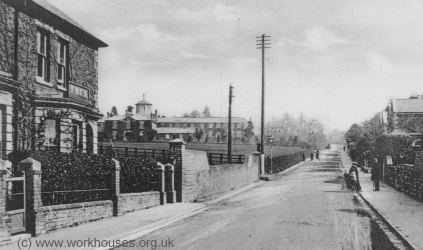
Blandford workhouse from the south, early 1900s.
© Peter Higginbotham.
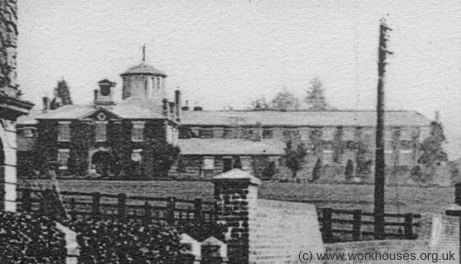
Blandford workhouse, early 1900s.
© Peter Higginbotham.
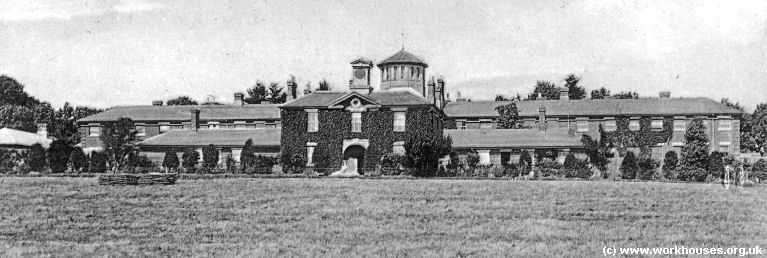
Blandford workhouse, early 1900s.
© Peter Higginbotham.
Most of the new workhouse building was demolished in the early 1970s, although the entrance block survives. The site is now used as a residential care centre.
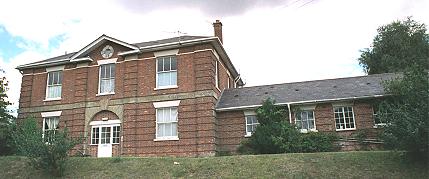
Blandford, 2000.
© Peter Higginbotham.
Staff
Inmates
Records
- Dorset History Centre, Bridport Road, Dorchester DT1 1RP. Holdings include: Register of inmates (1761-5, 1793, 1805); Guardians' minutes (1835-1930); etc.
Bibliography
- Dorset Workhouses (1980, Dorset Countryside Treasures).
Links
- None.
Unless otherwise indicated, this page () is copyright Peter Higginbotham. Contents may not be reproduced without permission.


